 |
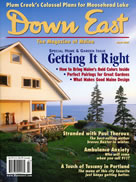 At Home In Maine At Home In Maine
A Camden photographer has built a career out of training his camera on the "rightness" of Maine architecture. By Bruce Snider.
Reprinted by permission from the March 2005 issue of Down East magazine. Copyright 2005 by Down East Enterprise, Inc., Camden, Maine. All rights reserved.
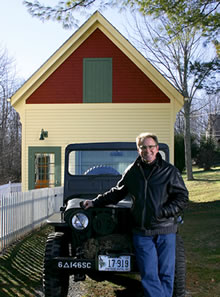 If you have spent any time looking at photographs of Maine houses in glossy shelter magazines, you have probably seen the work of Brian Vanden Brink. The Camden-based photographer has long been Maine's prime conduit of architectural imagery to the world beyond its borders. But if his name doesn't ring a bell, it comes as no surprise. Magazines rely heavily on photographs to deliver their message — more so, perhaps, than we writers care to admit — but photographers themselves are the most invisible of contributors. When we encounter an exquisitely crafted photograph, it is the scene itself that we note, not the photographer's art. If you have spent any time looking at photographs of Maine houses in glossy shelter magazines, you have probably seen the work of Brian Vanden Brink. The Camden-based photographer has long been Maine's prime conduit of architectural imagery to the world beyond its borders. But if his name doesn't ring a bell, it comes as no surprise. Magazines rely heavily on photographs to deliver their message — more so, perhaps, than we writers care to admit — but photographers themselves are the most invisible of contributors. When we encounter an exquisitely crafted photograph, it is the scene itself that we note, not the photographer's art.
For this photographer, though, anonymity is no slight. At fifty-three, he has devoted his entire professional life to creating pictures that speak for themselves. In compiling some of the best of them for his first book, At Home in Maine: Houses Designed to Fit the Land (to be published this spring by Down East Books), one of his first concerns was that it be "not a book about me." That sentiment, entirely characteristic of the man, belies the influence he has exerted on the public imagination. One of the country's foremost architectural photographers, Brian Vanden Brink has done as much as any artist of his generation to shape our collective view of Maine architecture — and of Maine itself.
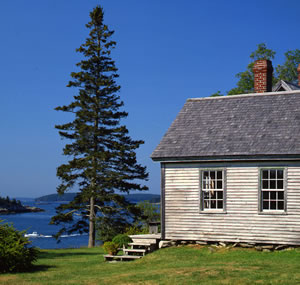 I met Brian in 1982. I had found a job as an architect's draftsman in the old ramshackle Rockport High School building, which by then had been converted to offices and apartments. Brian rented studio space across the hall, and I often slipped away to see what he was up to. I was interested in photography as well as architecture, and Brian labored at the fascinating intersection of the two. He worked then — as he still does — with a bulky view camera, the kind that requires the photographer to huddle under a cloth hood, composing images upside down on a frosted glass screen. With this unwieldy device Brian created gorgeous four-by-five-inch transparencies, giant slides, if you will, each of which seemed a window into a smaller, perfected world. I met Brian in 1982. I had found a job as an architect's draftsman in the old ramshackle Rockport High School building, which by then had been converted to offices and apartments. Brian rented studio space across the hall, and I often slipped away to see what he was up to. I was interested in photography as well as architecture, and Brian labored at the fascinating intersection of the two. He worked then — as he still does — with a bulky view camera, the kind that requires the photographer to huddle under a cloth hood, composing images upside down on a frosted glass screen. With this unwieldy device Brian created gorgeous four-by-five-inch transparencies, giant slides, if you will, each of which seemed a window into a smaller, perfected world.
Brian was good company, genial but opinionated, and unfailingly modest about his accomplishments. He preferred to discuss the architecture itself. We had both been drawn to Maine by the spare beauty of its landscapes and of the old buildings that seemed to dwell so comfortably in them. We approved of new work that built on lessons from the past, and bemoaned the homogenized development that we saw creeping up the coast from the south. Our objections were aesthetic, but in Brian's view there seemed a moral dimension to the matter as well. Maine's natural settings and architectural traditions offered such clear guidance on how to do the right thing that to choose the one wrong thing — a 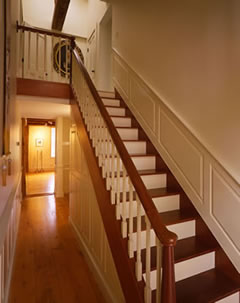 building that could be anywhere — was almost inexcusable. Brian held himself to high standards, almost to the point of perfectionism, and it surprised and disappointed him when others failed to do likewise. building that could be anywhere — was almost inexcusable. Brian held himself to high standards, almost to the point of perfectionism, and it surprised and disappointed him when others failed to do likewise.
For one with such New England sensibilities, Brian grew up at the unlikely remove of Des Moines, Iowa. He came, with his wife, Kathleen, in 1978 to attend a three-month course at the Maine Photographic Workshops (now the Rockport College). They stayed, he says, "because we couldn't afford to go anywhere else." Kathleen took a job at a local preschool and stalwartly supported her husband's dream of making a living with his camera. "What that translated to in the beginning was poverty," remembers Brian, who had intended to pursue photography as a fine art. With a baby on the way, that seemed impractical, but his own portfolio suggested another direction. His early work tended toward black-and-white studies of abandoned grain elevators and barns." They were almost all inanimate structures," he says. At the time, "I didn't even know that there was such a thing as architectural photography."
Undeterred, he introduced himself to local architects, with whom he quickly established a rapport, and began to shoot their buildings. Compensating for his lack of formal training, Brian says, "I devoured a lot of film. That was my training: shoot a lot, make a lot 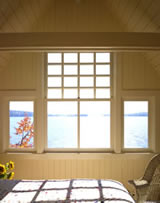 of mistakes, and figure out what I had done wrong and how to fix it." The method apparently succeeded rather quickly. Architects, a discerning audience if ever there was one, liked the way he captured their work, and one thing led to another. "Every time I got a new job I would put that in my portfolio and take that and go look for the next job." of mistakes, and figure out what I had done wrong and how to fix it." The method apparently succeeded rather quickly. Architects, a discerning audience if ever there was one, liked the way he captured their work, and one thing led to another. "Every time I got a new job I would put that in my portfolio and take that and go look for the next job."
But Maine architects were — and are — a relatively small fraternity, and face-to-face marketing ate up time better spent behind the camera. So Brian began to call on magazines, too. His first Down East shoot, he recalls, came in 1980 or 1981." They sent me to photograph some people who were canning fiddleheads," he remembers." It wasn't architectural work, but it was work." And the assignments that followed did more than help pay the bills; they were his grand tour of the state. He shot architectural icons like the Olson House, made famous by Andrew Wyeth's Christina's World, small towns, and whole regions he might otherwise have never seen. The experience deepened his appreciation for his adopted home state." Everything's not perfect," he says, approvingly." 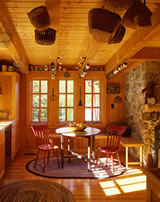 It's rough, it's hard-edged, and it doesn't look like any other part of the country. I love living here. It's a perfect fit for me." It's rough, it's hard-edged, and it doesn't look like any other part of the country. I love living here. It's a perfect fit for me."
As Brian's name became better known, his work with Down East shifted toward architectural feature stories. Increasingly he also brought Maine architects to the attention of national magazines like Architectural Digest, Architectural Record, and Fine Homebuilding, shaping the outside world's view of Maine architecture — and of Maine itself.
"When the work of younger Maine architects became publishable, he was right there with us," says Lincolnville architect John Silverio, who has known Brian for more than twenty years." We worked together to get images into the press and show things in the best light." For Silverio, that means capturing the relationship between a structure and its natural setting." He sets my buildings the way I like to see them set, from the distance I like to see them at. He'll work in distant views, he'll work in clouds, he'll work in trees," whatever it takes to ground the building in its context. Brian shoots Maine houses in a way that makes clear they could not be anywhere but Maine.
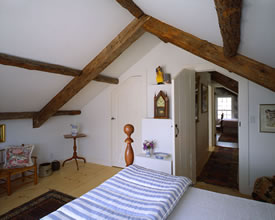 "He kind of channels architecture from Maine to the world," says Portland architect Rob Whitten, with images that convey not just the way a building looks, but how it might feel to be there. "He's very good at letting you see yourself in the photograph. If it's morning light, he's got coffee and a croissant in it." If it's evening, there is a fire in the fireplace. "You're always looking out a window or through an open door." And while the shots virtually never include people, Whitten says, "There is a person in the image: It's the viewer. It's you." "He kind of channels architecture from Maine to the world," says Portland architect Rob Whitten, with images that convey not just the way a building looks, but how it might feel to be there. "He's very good at letting you see yourself in the photograph. If it's morning light, he's got coffee and a croissant in it." If it's evening, there is a fire in the fireplace. "You're always looking out a window or through an open door." And while the shots virtually never include people, Whitten says, "There is a person in the image: It's the viewer. It's you."
It's about creating an emotion in people that goes deep inside them and makes them say, 'I want to be there,' " Brian explains. "But that doesn't just happen automatically." To look this inviting, a house must be fluffed up like a pillow: porch chairs turned subtly toward the view, a door set just ajar, a fire built in the fireplace. And, crucially, the photographer must be in the right place when the light arrives, ready to trip the shutter and move on to the next shot. "You've got to 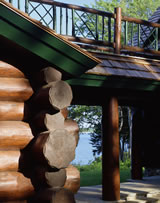 resolve all those design issues in a very short period of time. It's got to happen now, now, now. And that will send you home at night exhausted." Years of motel stays have drained the novelty from location work, and to continue moving nimbly with heavy equipment Brian trains with weights at the Y. But the work still inspires him. "I love being part of the architectural world. I love to be around architecture; I love to look at it." resolve all those design issues in a very short period of time. It's got to happen now, now, now. And that will send you home at night exhausted." Years of motel stays have drained the novelty from location work, and to continue moving nimbly with heavy equipment Brian trains with weights at the Y. But the work still inspires him. "I love being part of the architectural world. I love to be around architecture; I love to look at it."
The right kind of architecture, that is. In At Home in Maine, he marshals all the powers of his craft to make a case for the right kind, for architecture appropriate to Maine. The book pairs Brian's photographs of exemplary old, new, and renovated Maine houses with a lucid analysis of each by Camden architect Christopher Glass. In words and images, it lays out "why these houses work, in their historical context as well as in the contemporary world." The goal, Brian says, is to help readers who build or renovate homes in 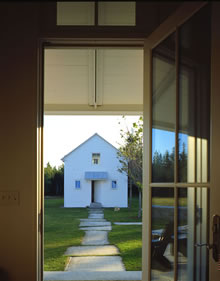 Maine "come up with something that's reasonable and human and responsible, that isn't an assault on the land. I want to see people build responsibly — and modestly." And if, in the process, he sheds some of his accustomed anonymity, it is not due to any failure of his own modesty. "I shoot the work of others; I didn't design the houses I shoot," he says. "It's the light that people respond to, and I didn't create the light." Maine "come up with something that's reasonable and human and responsible, that isn't an assault on the land. I want to see people build responsibly — and modestly." And if, in the process, he sheds some of his accustomed anonymity, it is not due to any failure of his own modesty. "I shoot the work of others; I didn't design the houses I shoot," he says. "It's the light that people respond to, and I didn't create the light."
The first formal retrospective of Brian Vanden Brink's work will be on display at the Center for Maine Contemporary Art in Rockport from April 17 through June 4. Call 207-236-2875 for information.
|
 |



